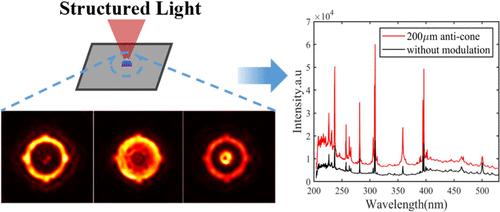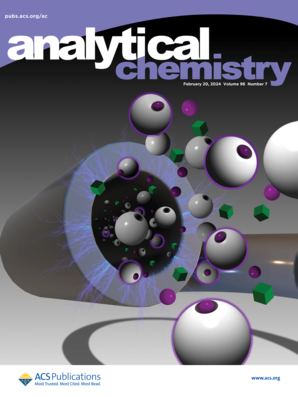Laser-Induced Breakdown Spectroscopy Using 2D Structured Light: A Case of Spectral Signal Enhancement on Metal Samples
IF 6.7
1区 化学
Q1 CHEMISTRY, ANALYTICAL
引用次数: 0
Abstract
Laser-induced breakdown spectroscopy (LIBS), an elemental detection technique with great potential, faces many problems mainly caused by the nonideal plasma properties in the detection window. The 2D laser energy distribution on the sample surface has a crucial impact on the plasma properties and spectral emission. However, relevant studies are still limited, lacking a good degree of freedom (DOF) to systematically explore its influence. In this work, 2D structured light was generated by using a spatial light modulator (SLM). Various focal patterns with different cross-section areas were tested using metal samples so that the effects of the focal spot structure and cross-section area could be separated. The arrow-target and anticone of 200 μm diameter resulted in a line enhancement factor of more than 3 for a pure aluminum sample and a factor of about 6 for the pure copper sample over that without beam modulation. A significant improvement in the signal-to-noise ratio and a reduction in the limit of detection (LOD) of Cr, Mn, Si, Cu, and Al by a factor of about 6 were also achieved with the bearing steel sample. To better understand the mechanism behind such improvements, time-resolved spectra were measured, from which the electron density and plasma temperature evolution were calculated. The results showed that with anticone and arrow-target patterns, the electron density was increased by more than 50%, while the plasma temperature varied less than 500 K, suggesting an evident ablation enhancement. The fast images of plasma self-emission proved that the laser energy distribution substantially influenced the morphology of the plasma plume. The plasma cores produced by the anticone and arrow-target focal patterns were more compact after the expansion and cooling process, which could reduce the mixing of plasma plumes and ambient air. Thus, with the first application of SLM in LIBS, focal spot structures of micrometer resolution could be rationally designed and generated with a high DOF. Substantial spectral signal enhancement and a much lower LOD were achieved. This study provides new insights into the role of focal patterns in plasma properties, suggesting the future possibility of plasma control using structured light.

求助全文
约1分钟内获得全文
求助全文
来源期刊

Analytical Chemistry
化学-分析化学
CiteScore
12.10
自引率
12.20%
发文量
1949
审稿时长
1.4 months
期刊介绍:
Analytical Chemistry, a peer-reviewed research journal, focuses on disseminating new and original knowledge across all branches of analytical chemistry. Fundamental articles may explore general principles of chemical measurement science and need not directly address existing or potential analytical methodology. They can be entirely theoretical or report experimental results. Contributions may cover various phases of analytical operations, including sampling, bioanalysis, electrochemistry, mass spectrometry, microscale and nanoscale systems, environmental analysis, separations, spectroscopy, chemical reactions and selectivity, instrumentation, imaging, surface analysis, and data processing. Papers discussing known analytical methods should present a significant, original application of the method, a notable improvement, or results on an important analyte.
 求助内容:
求助内容: 应助结果提醒方式:
应助结果提醒方式:


